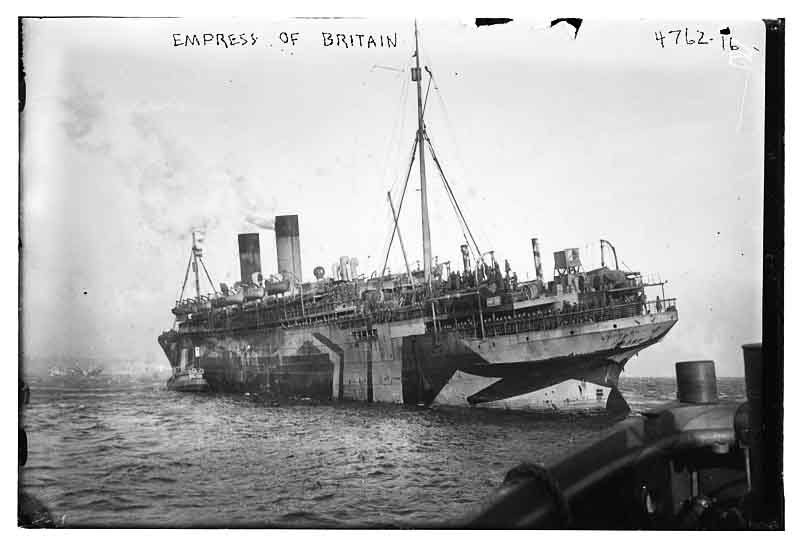It’s been a century since Niagara-on-the-Lake’s iconic clock tower cenotaph was erected. Then, in 1926, the Township of Niagara unveiled its own memorial in Queenston. In recognition of those who fought and died in two world wars and beyond, NOTL historian Ron Dale has been researching the stories of the people – all men – whose names are engraved on the two cenotaphs. This is one in a series of stories documenting and remembering the sacrifices of those commemorated on the municipal memorial in Queenston.
Ron Dale
Special to The Lake Report
On March 30, 1913, the passenger steamer SS Tunisian docked in Halifax after a nine-day voyage from Liverpool England.
Disembarking was 26-year-old Harold George Budd, planning to start a new life in Canada.
He was the second and youngest son of farmer John Budd and Lucy Lancaster of Sussex.
Harold had been employed by the London, Brighton and South Coast Railroad but resigned in 1911. When he arrived in Canada two years later, he described himself as a fruit farmer, and reported that his planned destination was Welland.
It was natural that he would gravitate to Niagara.
The First World War had been raging for a little over a year when Budd resolved to volunteer to fight in Europe. On Oct. 4, 1915, he enlisted in the 84th Overseas Battalion, Canadian Expeditionary Force, at the Hamilton Armoury.
At the time of his enlistment there was a common rumour heard across Canada that volunteers over the age of 27 would not be assigned front-line duties but would be employed in logistical tasks far from the field of battle.
A great number of men, on enlisting, wanted to experience the supposed adventure, excitement and glory of fighting and did not relish the idea of spending the war performing mundane tasks.
Many men lied about their ages, taking a few years off if they were over 27 and adding a few years on if under 18.
Budd stated on his attestation form that his birthday was Dec. 28, 1890. He was actually born on Dec. 28, 1887.
On June 18, 1916, Budd was back at the dock in Halifax. His unit boarded the SS Empress of Britain and 11 days later landed in Liverpool.
There, the 84th Battalion was broken up to bring the 75th and the 73rd battalions up to full strength. Budd was assigned to the 75th Battalion.
On Aug. 12, the 75th Battalion men disembarked at Le Havre, France. The 75th was mustered into the 11th Brigade, 4th Division of the Canadian Expeditionary Force.
Budd first experienced the hell of trench warfare later in August when his battalion manned front-line trenches in Belgium.
In September the battalion was sent to the Somme battlefront to reinforce the British and participate in the bloody Battle of the Somme in France. The Battle of the Somme was a long offensive, lasting from July 1 to Nov. 18, 1916, and achieving little.
For Budd and his comrades, their primary battle was the capture of the Regina Trench, a strong enemy position known to the Germans as the Staufen Riegel.
This battle within the larger Battle of the Somme lasted from Oct. 1 to Nov. 11.
Attacks by other divisions were unable to capture the trench for the first few weeks of October. Finally, the 4th Division, including Budd’s 75th Battalion, went “over the top” on Oct. 21, and drove the Germans from the western portion of the Regina Trench.
The following day they were able to repulse three major German counterattacks but suffered heavy losses in the action. Finally, on the night of Nov. 10-11 the 4th Division captured the eastern portion of Regina Trench.
Of all the Canadian casualties during the Battle of the Somme, most were suffered during the capture of Regina Trench.
In all, 14,207 men were killed, wounded, captured or missing in action. The Germans suffered heavier losses, including 1,000 men taken as prisoners of war.
Any thoughts of adventure and glory were dashed by the actual horror of the vicious trench warfare.
Budd was able to dodge bullets, bombs, shells, grenades, bayonets and poison gas, but became a casualty of the dreadful conditions faced by soldiers in the First World War.
On Jan. 6, 1917, he was admitted to the #18 Casualty Clearing Station medical facility and diagnosed with lobar pneumonia.
While he was reported as being slightly improved three days later, it was a false hope. He died on Jan. 17.
Harold George Budd lies buried in the Lapugnoy Military Cemetery in Pas de Calais, France, and is commemorated on the Queenston War Memorial.










